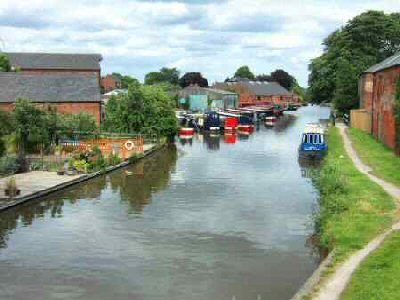SHARDLOW
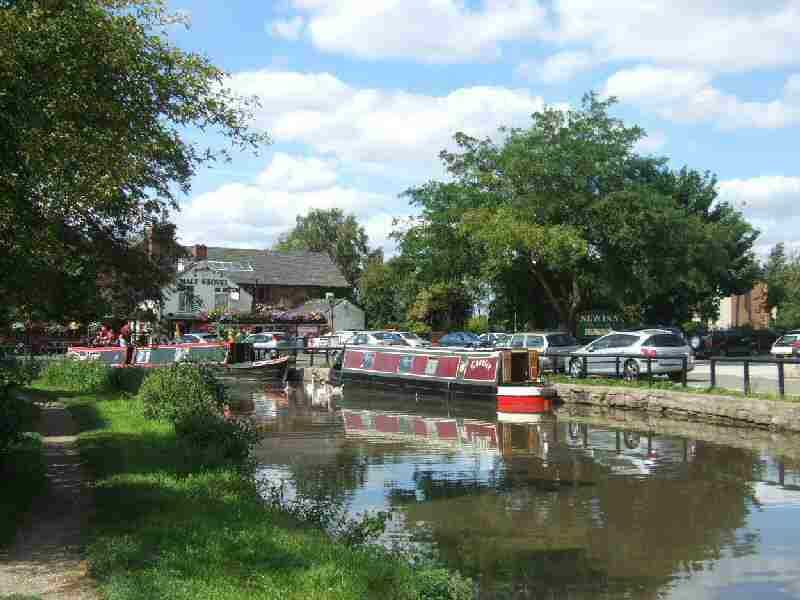
PLAN YOUR VISIT
Location: Shardlow is on the old A6 (now B5010) Derby to Loughborough Road (SK445303).
Visit: Check the opening times of Shardlow Heritage Centre. It features displays of canal and village life. Walk around the old village and stroll along the canal bank to Derwent Mouth Lock to watch boats negotiating the lock. A little further on, the River Derwent joins the River Trent.
Refreshments: Several pubs are close to the canal, and others, including restaurants and a café, are a short distance from the canal area.
Walk: Shardlow may not have the hills and splendid views found in other parts of Derbyshire, but it should not be missed for anyone interested in heritage and who enjoys walking by water. In summer and on weekends, the canal is alive with brightly painted long boats, moored beside the towpath or moving quietly along the canal. Watching boats negotiate locks is an absorbing experience, and locks are encountered on both walk sections.
Special Places of Interest in the Locality: Elvaston Castle Country Park, the first Country Park to be opened in Britain. Set in 200 acres of parkland with an ornamental lake, extensive gardens, stony grottoes, rock archways and many other interesting features. – Donington Park is a motorsport circuit located near Castle Donington in Leicestershire. – Visit Mercia Marina and enjoy the views, take a boat trip, go shopping and relax at one of the food and drink outlets at one of Derbyshire’s most popular tourist destinations.

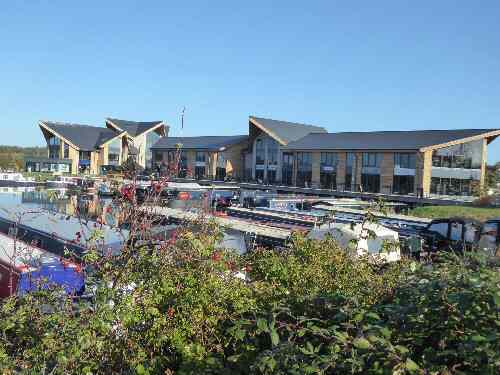
INTRODUCTION
Shardlow is one of the best-preserved inland canal ports in the country. It is a fascinating place to explore, still busy with boats, now used for leisure and not commerce. The boats range from traditional narrow boats with brightly painted liveries, in summer frequently be-decked with pretty boxes filled with flowers, to pleasure craft of all shapes and sizes. Boat people tend to be friendly and are usually more than happy to exchange a wave or a word or two with visitors, which adds to the enjoyment of a visit. All this activity is good news for the canal-side pubs, which team with customers in the summer and at the weekend.
A walk along the canal towpath brings you into contact with many of the old buildings of the Canal Age. They are now mainly used for different purposes, but are still largely intact. The massive warehouses that once stored ale, cheese, coal, cotton, iron, lead, malt, pottery, salt, and the wharves where goods were loaded and unloaded remain. These are where the skilled artisans worked: the boat builders and repairers, the chandlers, rope-makers, and blacksmiths.

WATERWAY TRANSPORT
Waterway traffic has always been important to the village. In the second half of the 17th century, Wilden Ferry, near Shardlow, had become the head of Trent navigation. This part of the river was leased from the Cokes of Melbourne Hall by the Forsbrooke family. They tried to monopolise river traffic between the ferry and Nottingham. They were so successful that Shardlow Hall was built out of the proceeds. In 1760, the Cavendish Bridge replaced the ferry. On the Derbyshire side is a toll board listing the crossing charges, ranging from two shillings and sixpence for coaches to a half penny for soldiers.
The use of river transport goes back much further than the days of the Wilden Ferry. In 1999, spring floods at Shardlow quarry exposed a twelve-foot-long oak boat in the bed of a former side channel of the River Trent. The boat, probably dating from the middle Bronze Age, about 1300 BC, still carried some of its quarried stone cargo. Archaeologists who examined the findings described their discovery as ‘spectacular.’ A small remnant and other discovery details are available for inspection at the Heritage Centre.
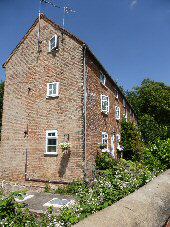
INDUSTRY
Industry’s rapid growth in the second part of the 18th century required an improved and inexpensive transportation system to be sustained. Much of the development was inland, so the coastal route was usually out of the question. Rivers, often obstructed by weirs and fish pools, could rarely be used for long-distance haulage. The growth of turnpikes improved roads, but they were not suitable for moving large volumes of goods. Packhorses were still relied on in Derbyshire to transport goods, slowly and laboriously. The time was ripe for a new form of efficient transportation of heavy goods.
JAMES BRINDLEY
A solution to the transportation problem came when James Brindley from Derbyshire astounded other engineers who laughed at his ultimately successful proposal to find an economical way of transporting coal from the Duke of Bridgewater’s estate at Worsley to Manchester.
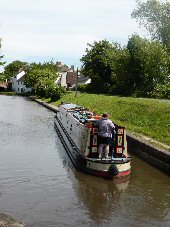
He did this by building an aqueduct over the River Irwell. It stood on three great stone arches, 17 feet up, with a towpath alongside the canal for the horses to pull the boats the 900 yards to the other side of the river. Brindley’s inventions continued, and his most celebrated was the Trent and Mersey Canal, known as the Grand Trunk. It connected canal systems throughout the country. After it opened, Shardlow became an important inland port.
RAILWAYS
The coming of the railways in the mid-1800s brought a decline in Shardlow’s prosperity. No longer was the canal busy with long-distance haulage. The warehouses were put to other uses, and the area began to decay. A limited amount of canal trade continued until the 1950s, when the last grain delivery was made. The growth of the leisure boat industry in recent years has once again returned Shardlow to its former vibrancy, with a splendid new marina and boat builders’ yard completed in 1975, which is always busy with boats.
THE VILLAGE
Industrial buildings are now recognised as a fundamental part of our heritage, and Derbyshire is fortunate to have such an important survivor of the Canal Age within its boundaries. The Clock Warehouse, combining a pub and restaurant, is a spectacular restoration of its original use, where goods were transferred from river barges to canal boats.
On the main A6, on the corner of Wilne Lane, is The Navigation Inn, which once served river traffic and is now a popular stopping point for visitors. Broughton House, on the other side of Wilne Lane, once belonged to one of the wealthy merchants, John Sutton, although he had never lived there. He built it to spoil the view of his business rivals—the Soresby family who lived at The Lady in Grey, a short distance further down Wilne Lane.
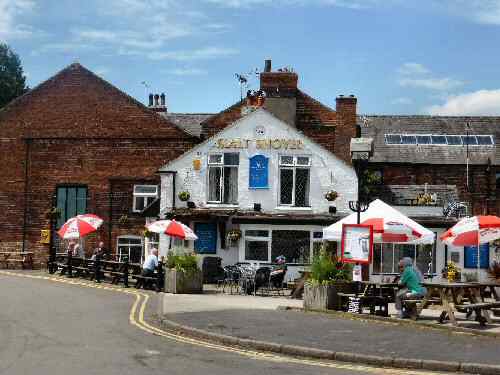
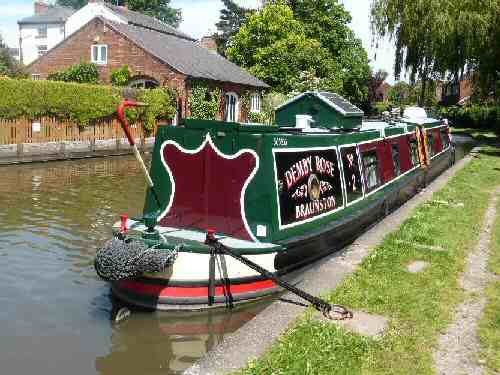
TEN FASCINATING FACTS ABOUT SHARDLOW
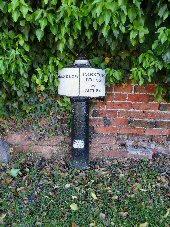
1. The Heritage Centre is in what was a farrier’s shop. Inside, it is well laid out and packs an incredible amount of information into a small space. Volunteers run it.
2. The restored iron mileposts along the canal bank are attractive. They mark every mile to the end of the canal at Preston Brook near Runcorn.
3. The New Inn and The Malt Shovel are popular canal-side pubs near Wilne Road.
4. By the village green are a row of old canal workers’ cottages and the village community centre.
5. Visit Shardlow Marina, which has a vast array of colourful boats, where you can also obtain refreshments.
6. On the other side of the B5010 from Shardlow Marina is the tiny hamlet of Cavendish Bridge. It shares its name with the bridge, where the river divides Derbyshire and Leicestershire.
7. Walking about one mile east along the canal bank, you arrive at Derwent Mouth Lock. The first lock encountered on the Trent and Mersey Canal. There is a special milepost situated alongside the lock that commemorates the canal. Here, you can stop and, if lucky, enjoy watching canal boats navigate the lock. Perhaps you can lend a hand with the lock gates.
8. A short distance after passing Derwent Mouth Lock, you get a clear view of where the River Derwent meets the River Trent and ends its journey through Derbyshire. A replacement bridge over the River Trent for Longhorse Bridge is a short distance further on.
9. The road bridge on the B5010 was called the Idle Bridge, as this was where men stood waiting for work offers.
10. Great Wilne is split from its church by the river and can only be reached from there on foot by crossing a pedestrian bridge. Anyone travelling by car from the village has a much longer journey.
SHARDLOW WALK

